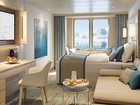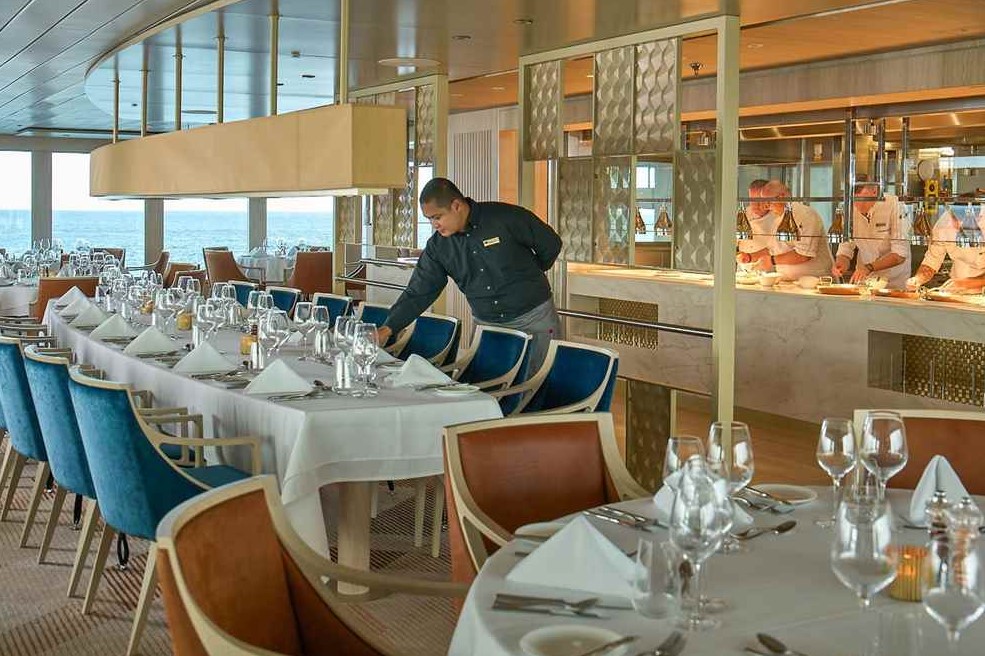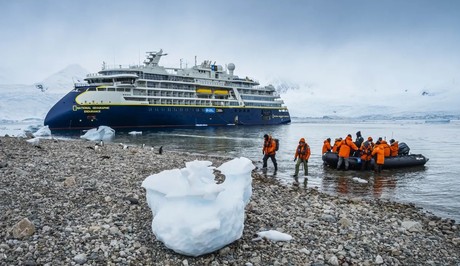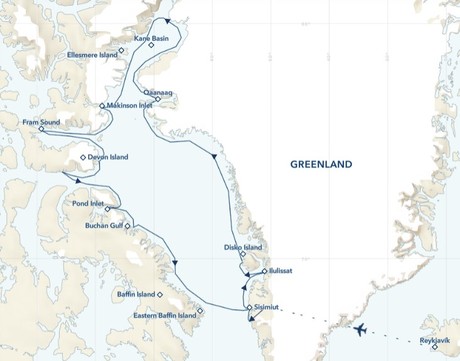High Arctic Archipelago: Canada and Greenland Expedition
Set off on a grand polar adventure that traces the spectacular icy shores of Western Greenland and Arctic Canada. Powered by the new National Geographic Endurance, sail into dramatic fjords, narrow straits, and breathtaking bays and call in on remote villages where Inuit communities have lived off the land for hundreds of years. Heading ever northward, we’ll follow leads through the ice to search for the King of the Arctic, the polar bear, along with other iconic wildlife from whales to walrus. Finally, in the farthest reaches of the region, discover the untamed beauty of the storied Northwest Passage and experience the intoxicating thrill of true exploration.
Highlights
• Travel well above 80º north into the fabled Northwest Passage and learn dramatic stories of the explorers and adventurers who sought this magnificent, icy frontier
• Glide between soaring icebergs at the mouth of Greenland’s Ilulissat Icefjord, a UNESCO World Heritage site
• Explore Ellesmere Island with binoculars at the ready to spot polar bears, walruses, ringed seals, belugas, bowhead whales, and the elusive narwhal
• Visit the “Jewel of the North,” Pond Inlet, a small Inuit community known for its friendly community and world-renowned soapstone carvings
• Marvel at the unique volcanic black sand beaches, hot springs, and waterfalls of Disko Island, a Greenlandic island often compared to Iceland
Upon arrival in Reykjavík, take a tour an excursion to see Iceland’s hot springs, beautiful Icelandic Horses, and a fascinating power plant. After lunch, check into our centrally located hotel. (L,D)
The morning is at leisure followed by lunch and a tour of the city ending at either the National Museum or the Whale Museum. Transfer to the airport for a chartered flight to Greenland and embark our ship at the head of Kangerlussuaq fjord, a 120-mile-long waterway whose name means “large fjord” in Greenlandic. (B,L,D)
Dozens of deep fjords carve into Greenland’s west coast, many with glaciers fed by the ice sheet that covers about 80 percent of the country. Discover this beautiful and rugged coastline in Zodiacs, keeping an eye out for humpback and minke whales. At Sisimiut, a former whaling port, visit the museum and stroll around a picturesque jumble of historic and modern wooden buildings. (B,L,D)
Sail into Qeqertarsuup Tunua, also known as Disko Bay, to explore the World Heritage site of Ilulissat Icefjord, a tongue of the Greenland ice cap that extends to the sea. Take an extraordinary cruise among towering icebergs at the mouth of the fjord. Visit the town of Ilulissat and walk to the archaeological site in Sermermiut, an abandoned valley previously inhabited by several distinct Inuit cultures. (B,L,D)
We continue our exploration of the Canadian High Arctic with a visit to the small Inuit community of Pond Inlet, Nunavut. Explore some of the beautiful bays and inlets along Baffin Island’s Lancaster Sound, a favorite Inuit hunting and fishing location for hundreds of years. Carved by Ice Age glaciers, Lancaster Sound is also the eastern gateway to the Arctic Archipelago, where European explorers like William Baffin first ventured in the 17th century to search for the Northwest Passage. Our days here will be spent searching for ringed seals, arctic foxes, walruses, and polar bears, as well as beluga and bowhead whales. Visit Devon Island and take a walk with our ship’s archaeologist to learn about the Thule people—ancestors of the modern Inuit—that once inhabited this region. (B,L,D)
We explore the ice-choked channels and glacier carved islands that stretch for hundreds of miles— a stunning display of raw geology. We’ll explore the rocky, “Mars-like” terrain of uninhabited Devon Island. We take our cues from nature: following wildlife, stopping for hikes on the tundra, dropping anchor in a beautiful fjord or an iceberg-strewn bay to explore and kayak beneath massive ice sculptures and soaring cliffs. Sail past the northernmost part of mainland North America in the Bellot Strait, one of the narrowest and most infamous of the passage. We’ll learn about the Inuit peoples who have hunted and fished here for thousands of years, as well as be on the lookout for the animals that call this region home such as ringed seals, arctic foxes, musk oxen, walruses, and polar bears, as well as beluga and bowhead whales. (B,L,D)
Heading ever northward, we make our way up the beautiful and remote east coast of Ellesmere Island. Cruise along scenic Smith Bay (a.k.a. Skog Inlet) bordered by a steep wall of mountains, with a glacial ice tongue which pours down the mountains on either side. Be up on the bridge as we search for a patch of "polar bear ice," the mixture of first-year and multi-year sea ice that is the preferred habitat of the ice bears. Our binoculars seek out any small ivory-colored dot on an otherwise white ice surface. We strain to see the dot move. Yes, it is a bear, spotted at a considerable distance. We approach, ever so slowly, stalking the polar bear much as the bear stalks seals on the ice. At the end of the bay, we go ashore to hike or kayak in picturesque surroundings. Ice is always present here. On our next day, we enter Buchanan Bay, and turn into Alexandra Fjord to reach the area of Skraeling Island. (“Skraeling” is the word that the Norse settlers of Greenland used for the Inuit.) This is the site of an important archaeological find. Norse artifacts show that the Norse traded with the natives here on Ellesmere Island, far north of their settlements on Greenland. Last summer, quite unexpectedly, we discovered the remains of a summer encampment of natives, we think of the Thule Culture (the third of the three Inuit cultures to occupy this area.) We saw rings of stones that held down the edges of skin tents against the wind, and stone chambers that might have been constructed for storage. Perhaps the Inuit camped at this very site as they traded with the Norsemen, exchanging skins and walrus ivory for European goods, especially metal. (B,L,D)
On these two days we explore to 80ºN and beyond, ice conditions permitting. We take full advantage of our “human resources”—our experienced captain, expedition leader and naturalists—as well as our technological resources. We chart where the ice is impenetrable and where there are leads guiding us to exciting discoveries. (B,L,D)
Marking the southern border of Melville Bay, Kiatassuaq Island means “a large torso” in the Greenlandic language. Known as an important area for whaling in the 19th century, we spend the day exploring the southern reaches of Melville Bay and shores of the island, marveling at the ice dispatched from the Greenland Ice Cap as well as being on the lookout for whales and other marine life. (B,L,D)
Continue south, stopping to explore the volcanic Disko Island, home to isolated Greenlandic settlements, dramatic cliffs laced with waterfalls, and black-sand beaches. (B,L,D)
Sail back into Søndre Strømfjord to Kangerlussuaq and disembark the ship. Take an evening charter flight to Reykjavík and transfer to the Marriott Keflavik Airport Hotel. On our final morning, you may choose to enjoy a soak in the Blue Lagoon or take a tour of the Reykjanes Peninsula before transferring to the airport for flights home. (Day 23: B,L,D; Day 24: B,L)
Itineraries are subject to change.
|
Book now |
More Cabin Categories & Prices Available
Category 1. From

Vessel Type: Expedition Ship
Passenger Capacity: 126
Length: 124 m
Built: 2020
National Geographic Endurance is a state-of-the-art expedition vessel purpose-built for year-round polar navigation. Named in honour of Sir Ernest Shackleton’s legendary Endurance expedition, she is the first polar ship in Lindblad’s history designed from the keel up for exploration. With an ice-class rating of PC5 (Category A) and a fully stabilised hull, she grants access to remote and often uncharted corners of the Arctic and Antarctica in exceptional comfort and safety.
Her revolutionary X-Bow®—a striking forward-leaning design—enables superior wave-cutting performance, ensuring a smoother, quieter ride and minimising spray on deck for better wildlife observation. On board, guests enjoy thoughtfully designed public spaces including a wraparound observation lounge, library, and an expedition base for gear and briefings. Dining is offered across three flexible venues, all serving sustainable, locally inspired cuisine. With a full suite of tools for exploration and a design deeply rooted in expedition heritage, Endurance is the ultimate platform for discovering Earth’s most remote regions.









Inclusions
• All accommodations, meals, and non-alcoholic beverages aboard ships
• Use of snorkeling equipment, wet suits, and kayaks (where available)
• Services of our expert expedition team and guest speakers
• Services of a ship physician on most voyages
• Certain hotels and meals ashore as indicated in the itinerary
• Round-trip transfers based on group flights
• Shore excursions, sightseeing, entrance fees, and special access permits
• Taxes, service charges, and tips (except for ship’s crew, at our guests’ discretion)
Exclusions
• Air transportation (except when we indicated in the itinerary, as included) Extensions
• Passport, visa, and immigration fees
• Travel Protection Plan
• Special and unique excursions such as scuba diving, flightseeing, etc. (where offered)
• Alcoholic beverages (alcohol is included on select ships)
• Items of personal nature
• Phone and Internet Service
• Laundry
• Gratuity for ship’s crew, at our guests’ discretion (crew tips are included on select ships)
Our Associates Include














